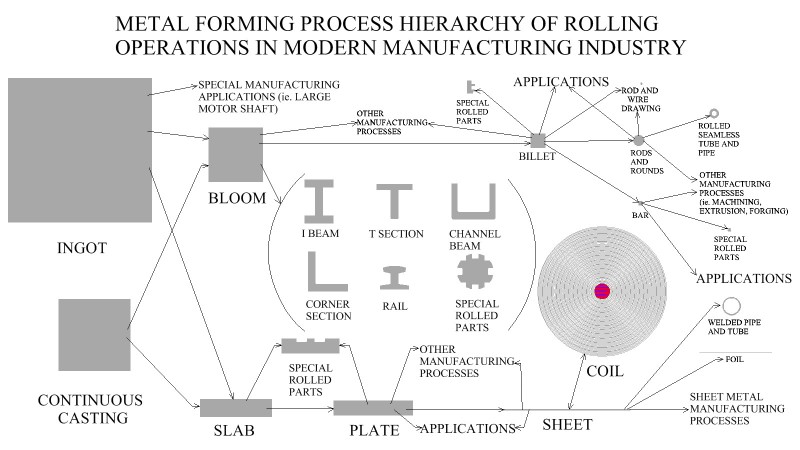Principles Of Metal Rolling
Most metal rolling operations are similar in that the work material is plastically
deformed by compressive forces between two constantly spinning rolls. These forces
act to reduce the thickness of the metal and affect its grain structure. The reduction
in thickness can be measured by the difference in thickness before and after the
reduction, this value is called the draft. In addition to reducing the thickness
of the work, the rolls also act to feed the material as they spin in opposite directions
to each other. Friction is therefore a necessary part of the rolling operation, but
too much friction can be detrimental for a variety of reasons. It is essential that in
a metal rolling process the level of friction between the rolls and work material is
controlled, lubricants can help with this. A basic flat rolling operation is shown in
figure:130, this manufacturing process is being used to reduce the thickness of a
work piece.
Figure:130
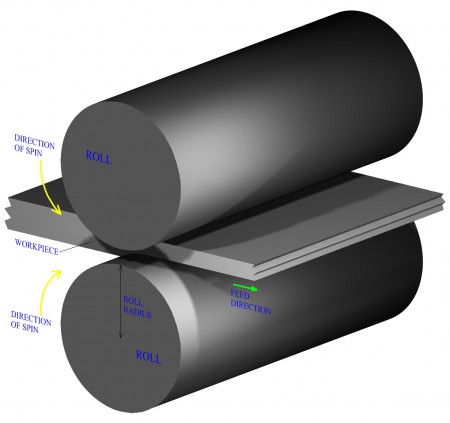
|
During a metal rolling operation, the geometric shape of the work is changed but
its volume remains essentially the same. The roll zone is the area over which the rolls
act on the material, it is here that plastic deformation of the work occurs. An important
factor in metal rolling is that due to the conservation of the volume of the material with
the reduction in thickness, the metal exiting the roll zone will be moving faster than the
metal entering the roll zone. The rolls themselves rotate at a constant speed, hence at
some point in the roll zone the surface velocity of the rolls and that of the material
are exactly the same. This is termed the no slip point. Before this point the
rolls are moving faster than the material, after this point the material is moving faster
than the rolls.
Figure:131
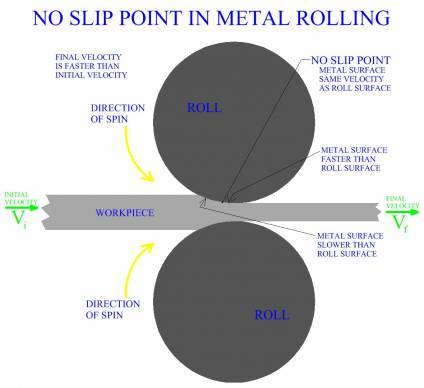
|
Sometimes in metal rolling practice, tension, (force), is applied to a work piece as it
is being rolled. This tension may be applied to the front, (front tension), the back,
(back tension), or both sides. This technique will assist the forces necessary to form
the work, and is usually used on hard to roll materials.
Figure:132
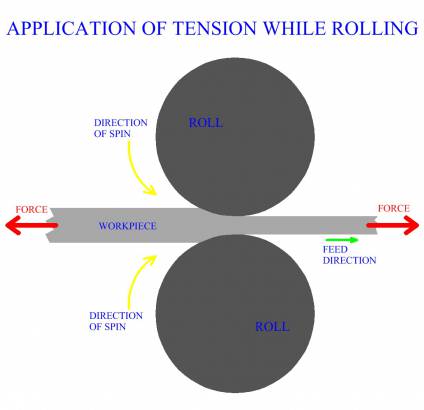
|
Spreading In Metal Rolling
In metal rolling operations, the plastic deformation causing a reduction in thickness
will also cause an increase in the width of the part, this is called spreading.
Figure:133
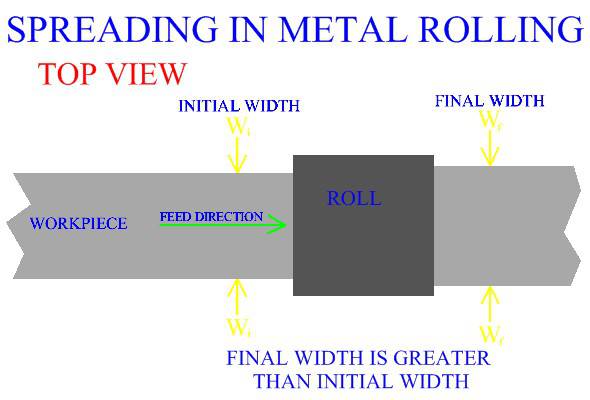
|
When the work being processed has a high width to thickness ratio, the increase in
width is relatively small and usually of no concern in industrial manufacturing practice.
In cases of low width to thickness ratios, such as a bar with a square cross section,
spreading can be an issue. Vertical rolls can be employed to edge the work and
maintain a constant width.
Figure:134
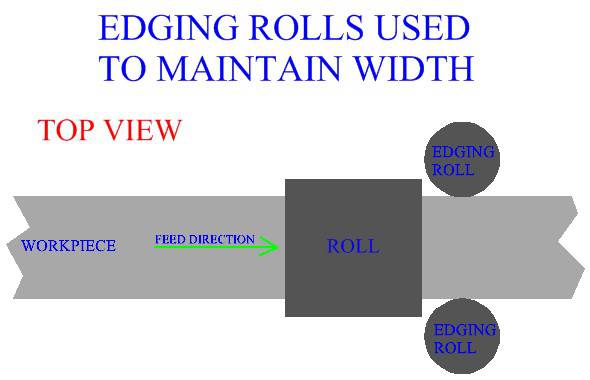
|
Grain Structure In Metal Rolling
In common industrial manufacturing industry, the ingot or continuous casting
is hot rolled into a bloom or slab. In addition to producing a useful shape for
further processing, the hot rolling process converts the cast grain structure into a
wrought grain structure. The initial cast material will possess a non uniform
grain structure, typically large columnar grains that grow in the direction of
solidification. These structures are usually brittle with weak grain boundaries.
Cast structure characteristically contains many defects such as porosity caused by
gases, shrinkage cavities, and solid inclusions of foreign material that becomes
trapped in the metal, such as metallic oxides.
Rolling a metal above its recrystallization temperature breaks apart the old
grain structure and reforms a new one. Grain boundaries are destroyed and new
tougher ones are formed, along with a more uniform grain structure. Metal rolling
pushes material, closing up vacancies and cavities within the metal. In addition,
hot rolling breaks up inclusions and distributes their material throughout the work.
Figure:135
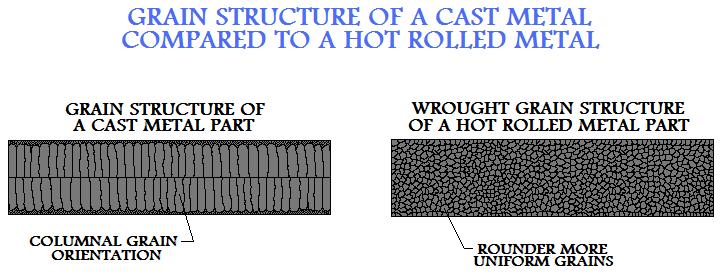
|
It should be apparent that the advantages of metal forming are not just in the creation
of useful geometric forms but also in the creation of desired material properties as well.
Cold rolling processes as discussed earlier, are useful for imparting strength and
favorable grain orientation. Since metal rolling affects grain orientation, a part can
be rolled in a way as to create grains oriented in a direction such that they give
directional strength to a part useful to that part's specific application. An example of
this can be the difference in grain structure between the threads of a machined bolt
and a rolled bolt. The favorable grain orientation of the cold rolled bolt will give
it directional strength beneficial to its application.
Figure:136
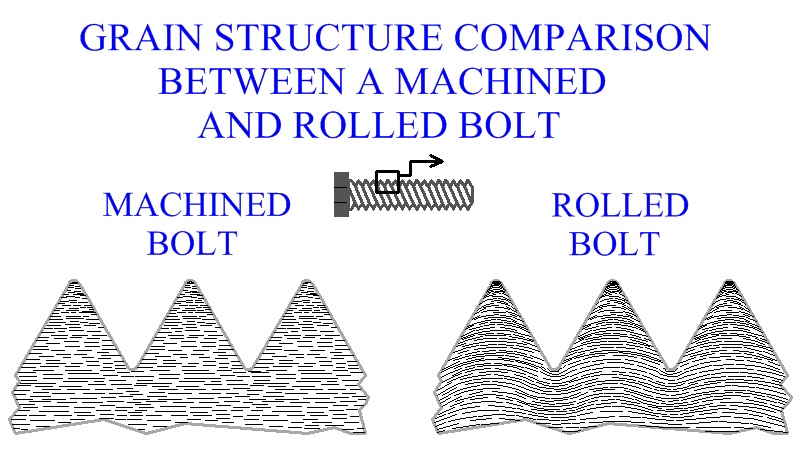
|
Rolls For Metal Rolling
Metal rolling manufacturing can produce a wide range of different products.
The width of rolled work can be as much as several meters, or narrower than a
thousandth of an inch. Metal rolling manufacture also creates rolled work over a
wide range of thicknesses. Metal plates for some boilers may be rolled to a thickness
of 12 inches, while foil for wrapping cigarettes and candy can be .0003 inches
thick. Rolls used in metal rolling are of various sizes and geometries. In flat rolling processes,
during industrial manufacture, the rolls may typically be 24 to 54 inches in diameter. In some
metal rolling operations, in the forming of very thin work, the rolls can be as small as 1/4 inch.
Rolls are subject to extreme operating conditions during the metal rolling process.
Conditions include, tremendous forces, bending moments, thermal stresses, and wear.
Roll materials are selected for strength,
rigidity, and wear resistance. Roll materials vary dependent upon the specific metal rolling
process. Common roll materials are cast iron, cast steel, and forged steel. Forged
rolls are stronger and more rigid than cast rolls but are more difficult to manufacture.
In industrial metal manufacturing processes, rolls are commonly made from nickel steel or molybdenum
steel alloys. With metal rolling operations of certain materials, rolls made of
tungsten carbide can provide extreme resistance to deflection.
Roll Deflections
Strength and rigidity are important characteristics of the rolls used to form
product in metal rolling manufacture. The particular attributes of the rolls will
affect dimensional accuracy as well as other factors in the operation. During the
rolling process great forces act upon the rolls. Rolls will be subject to different
degrees of deflection. In any particular metal rolling process, it is important to understand
how these deflections will affect the rolls and hence the work being rolled. The
rolls initially start out flat. During a basic flat rolling operation, it can be observed
that the work material will exert greater force on the rolls towards the center of the
material than at its edges. This will cause the rolls to deflect more at the center, and
hence gives the work a greater thickness in the middle.
Figure:137
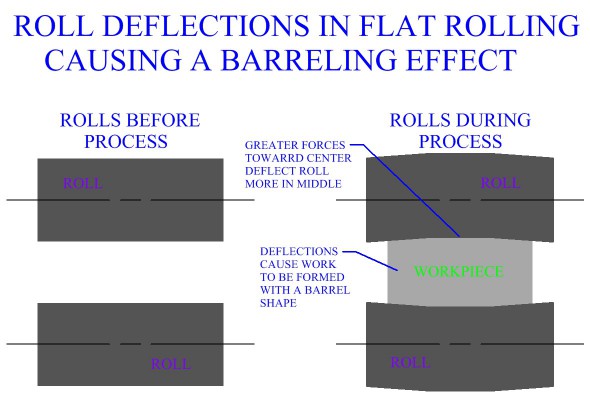
|
To solve this problem in industrial metal rolling manufacture, the rolls are often
ground so that they are thicker towards the center in such a way as to exactly
offset the deflection that will occur during the process. This extra thickness is
called camber.
Figure:138
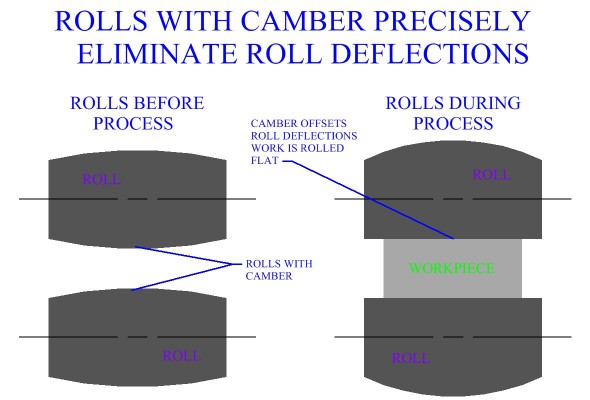
|
The camber that must be ground into a roll is very specific to a particular work
width, material, and force load. A roll must usually be manufactured for only one
metal rolling process. In some industrial metal rolling processes, rolls are given temporary
camber by applying forces through their bearings. Another way that rolls deflect is
by the shortening of their radius along the contact of the work. In other words, they
flatten like a tire on a car might. This type of deflection is important to consider in
manufacturing practice, as it will affect roll radius calculations and friction.
Defects In Metal Rolling
A wide variety of defects are possible in metal rolling manufacture. Surface
defects commonly occur due to impurities in the material, scale, rust, or dirt.
Adequate surface preparation prior to the metal rolling operation can help avoid
these. Most serious internal defects are caused by improper material distribution
in the final product. Defects such as edge cracks, center cracks, and wavy edges,
are all common with this method of metal manufacturing.
Figure:139
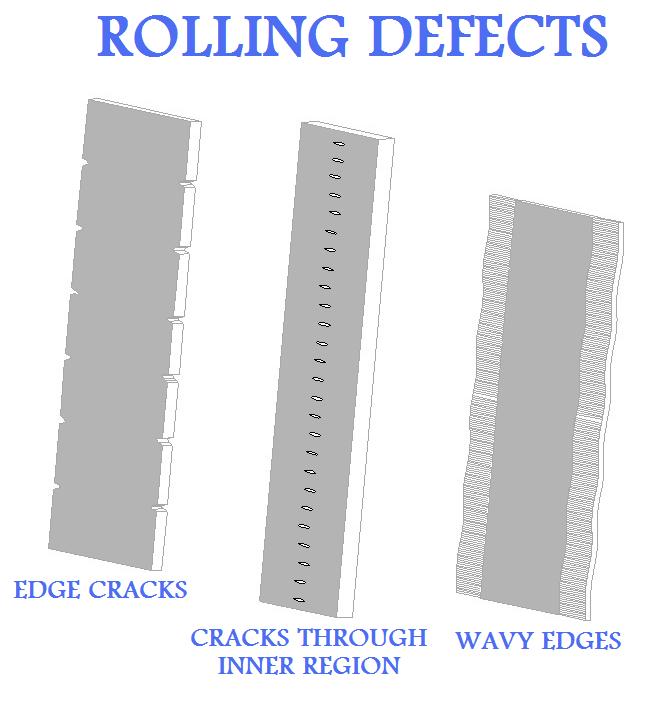
|
Often times a sheet is not defective, it is just not flat enough. In sheet metal
industrial practice, a sheet may be passed through a series of leveling rolls that
flex the sheet in opposite directions to flatten it. Another interesting defect that
can occur in flat rolling is alligatoring, where the work being rolled actually splits
in two during the process. The two parts of the work material travel in opposite
directions relative to their respective rolls.
Figure:140
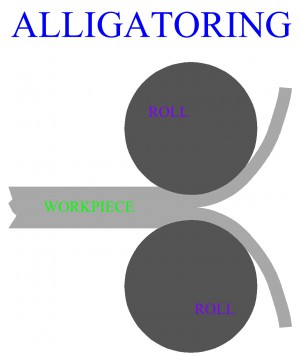
|
In shape rolling manufacture, a work piece will often experience different amounts of
reduction in different areas of its cross section. One of the goals of roll pass design is to
properly design a series of reductions in such a way as to mitigate the relative differences in
shape change between areas, in order to avoid material defects.
Improper reductions of the product can cause
warping or cracking of the material. Metal rolling practice is not always the cause of
warping or cracking, sometimes defects in the metal being rolled may be the reason.
Figure:141
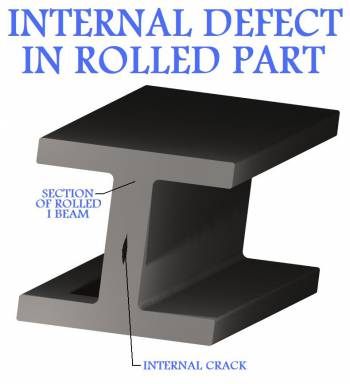
|
Rolling Mills
In metal forming industry, rolls themselves do not function in isolation. In a metal rolling
process, rolls, stands, bearings, housing, motors, and other mechanical equipment are
all a necessary part of the manufacturing operation. The place where all the equipment
for metal rolling manufacture is set up is called a rolling mill. Rolling mills often vary in the
type, number, and position of rolls. Rolling mill arrangements commonly used in
manufacturing industry today include the two high mill, the two high reversing mill,
the three high mill, the four high mill,
the cluster mill, and the tandem rolling mill.
Figure:142
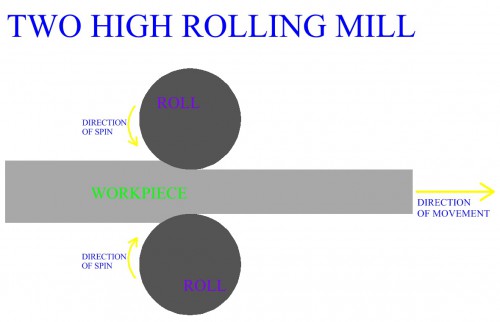
|
In the two high reversing mill the direction of spin of the rolls can be reversed.
This enables the work to travel through in one direction, then back through in the
other direction. A series of reductions can be made using the same set of rolls, by
passing the work back and forth. Disadvantages of the two high reversing mill
include the mechanical requirements and power to constantly overcome and
reverse the angular momentum of the rolls.
Figure:143
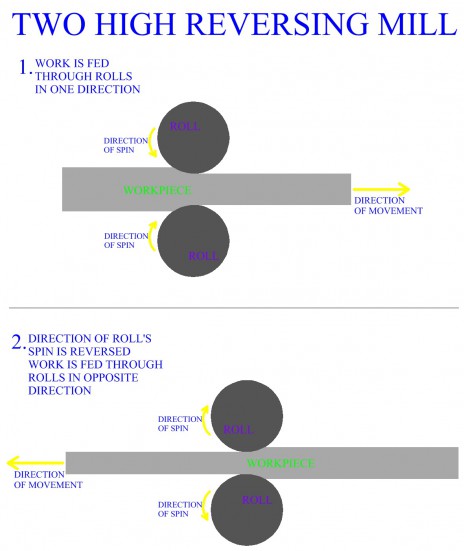
|
The three high rolling mill utilizes the principle of passing the work back and forth to
achieve a series of reductions. Unlike the two high reversing mill, the three high mill has
three rolls that always spin in the same direction. An elevator mechanism lifts and lowers
the work so that it can be passed back and forth through the rolls.
|
